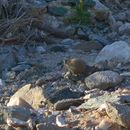en
names in breadcrumbs


Little is known about communication among Petromus typicus, although they have been observed to emit a single whistling note as a warning signal to other rock rats when a predator is sighted.
Communication Channels: acoustic
Perception Channels: visual ; tactile ; chemical
Rock dassies are not currently considered endangered, threatened or vulnerable.
US Federal List: no special status
CITES: no special status
IUCN Red List of Threatened Species: least concern
The economic importance of Petromus typicus is unknown.
The economic importance of Petromus typicus is unknown.
As mentioned, Petromus typicus are prey for aerial predators. They are also seed predators, and possibly seed dispersers.
Two parasites of Petromus typicus are mentioned in current literature, Acanthoxyurus shortridgei monnig and Heteroxynema cafer. Both parasites are nematodes. The specific physiological effects of these parasites on rock rats are unknown.
Ecosystem Impact: disperses seeds
Commensal/Parasitic Species:
Petromus typicus are herbivores. They feed on the blossoms of certain desert and steppe plants, as well as on greens, seeds, berries and fruits that they seek on the ground or in bushes.
Plant Foods: leaves; seeds, grains, and nuts; fruit; flowers
Primary Diet: herbivore (Folivore )
The rock rat or dassie rat is found in western South Africa, Namibia and southwestern Angola.
Biogeographic Regions: ethiopian (Native )
Petromus typicus are generally found in crevices and rocky cavities of stony deserts. They live in the rocky areas of hills and mountains, where they rest and sun on warm rocks beneath overhangs for protection from flying predators. Mean annual rainfall in areas where Petromus typicus live is usually greater than 25 mm, and their habitat boundaries are often limited by areas of moist woodlands or cold, wet winters. Rock rats seek food on the ground or in low bushes.
Habitat Regions: temperate ; terrestrial
Terrestrial Biomes: desert or dune ; mountains
The lifespan of Petromus typicus is unknown.
Rock rats are small mammals, ranging in size from 100 to 300 grams. They have flat skulls with short ears, long black facial whiskers, yellowish noses, and hypsodont cheekteeth. Their teeth include narrow incisors and total 20 in number, in the pattern 1:1; 0:0; 1:1; 3:3. Their feet and claws are narrow, the forepaws have 4 digits and the hindpaws have 5 digits. Rock dassies' fur grows in clusters of 3-5 hairs, creating a bristly appearance, but it is generally smooth and soft to the touch. Their bodies blend in with the rocks, the dorsal side having a greyish tawny color and the ventral side grey or yellow. They also have incredibly flexible axial skeletons, allowing them to slip through narrow rock cracks for protection and shelter. With their short legs and squat build, these mammals are more adapted to running rather than jumping and locomote by running over the rocks of their habitat. Testes in the males are semi-internal and generally inconspicuous. The nipples of female rock rats are lateral and high on level with the scapula, allowing young to nurse from the sides when hiding in crevices.
Range mass: 100 to 300 g.
Range length: 27 to 38 cm.
Other Physical Features: endothermic ; homoiothermic; bilateral symmetry
Sexual Dimorphism: sexes alike
Known predators of dassie rats include numerous birds of prey, although particular species are not mentioned in current literature. To avoid aerial predators, rock rats often forage beneath rocky overhangs, out of view from birds above them. They are also protectively colored, blending in well with their rocky surroundings.
Known Predators:
Anti-predator Adaptations: cryptic
Relatively little is known regarding the mating systems of Petromus typicus.
Mating takes place in early summer, during the months of November and December. This breeding season appears to be fixed, and may be related either to the onset of the rainy season or it may be endogenous to the animals.
Females give birth to 1-3 young in late December or early January after a gestation period of about three months, and the young are precocial, rather large, and covered with hair. Young rock rats begin to eat solid food at around 14 days, weaning about one week later. Petromus typicus reach adulthood near the age of nine months.
Breeding interval: Rock rats breed once yearly, in the summer months.
Breeding season: Mating occurs in November or December.
Range number of offspring: 1 to 3.
Average gestation period: 3 months.
Average weaning age: 21 days.
Average time to independence: 9 months.
Key Reproductive Features: seasonal breeding ; gonochoric/gonochoristic/dioecious (sexes separate); sexual ; viviparous
Average number of offspring: 1.9.
Little is known regarding the parental investment of Petromus typicus.